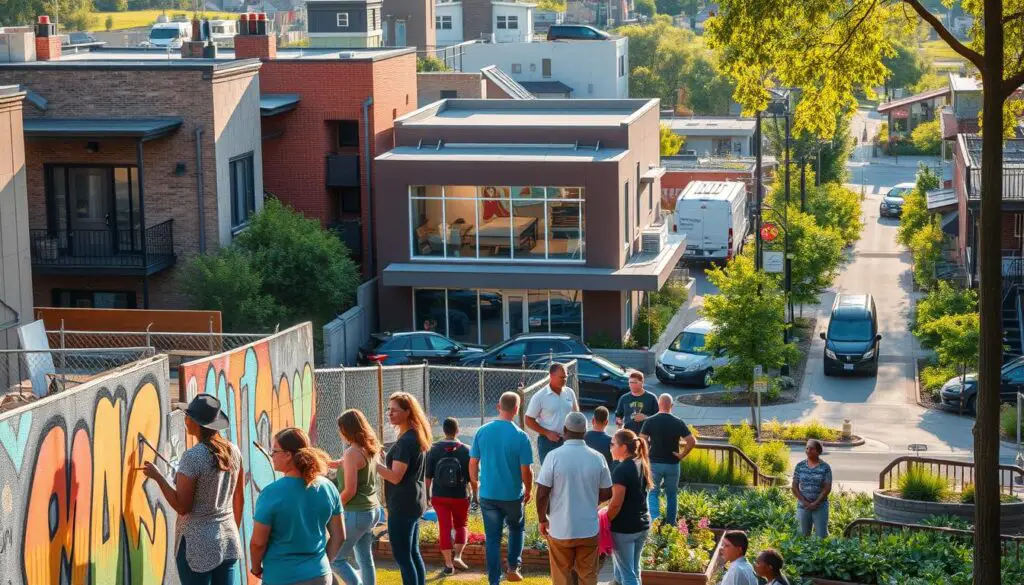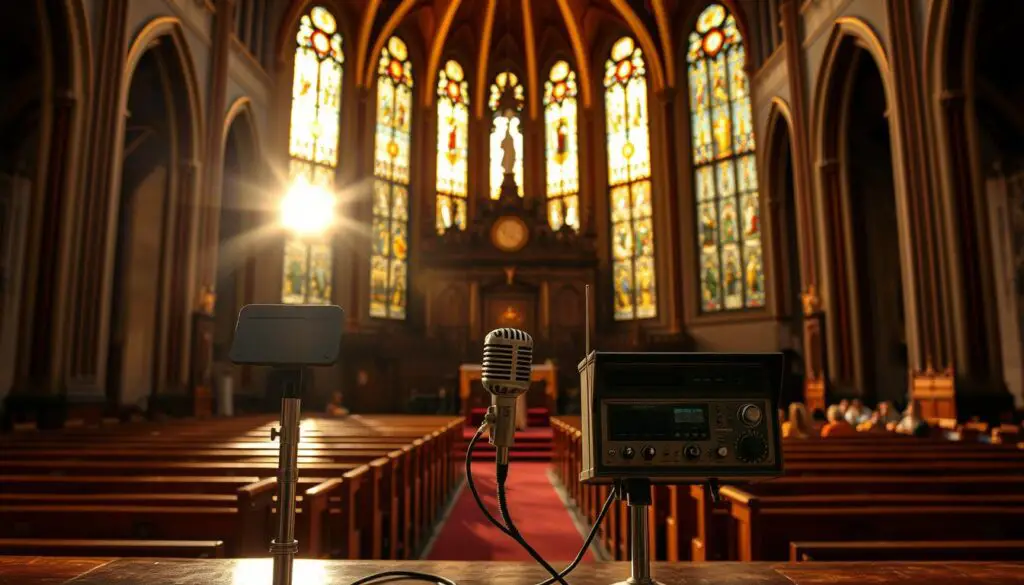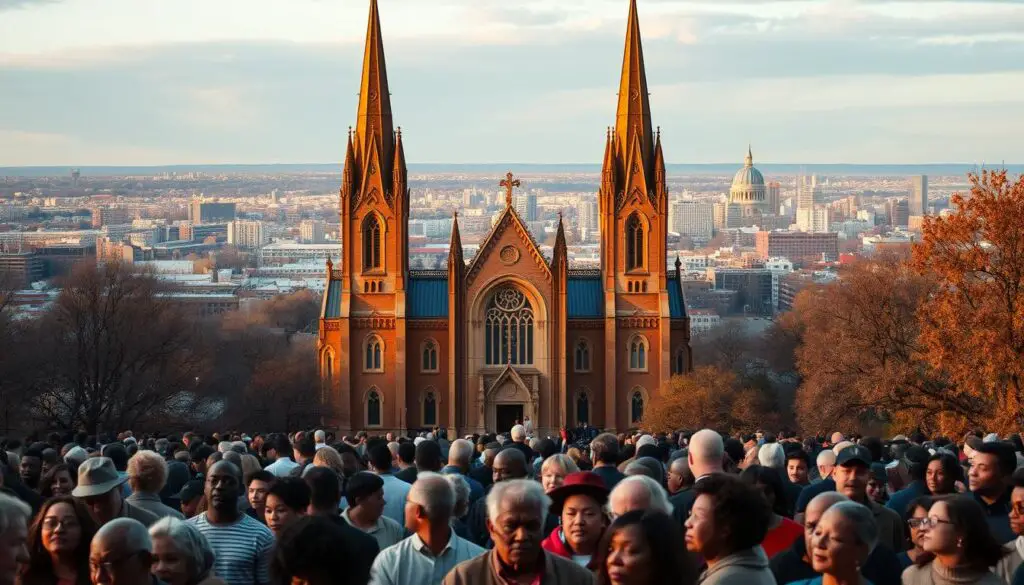For nearly a century, a beloved spiritual institution has stood as a cornerstone of faith in Ohio. Founded in 1934, this organization built a legacy of uplifting worship and community connection. Its journey reflects resilience, innovation, and a commitment to serving generations.
Originally known as the Akron Baptist Temple, the congregation underwent a meaningful transformation in recent years. Now called The Word Church, it continues honoring its roots while embracing modern outreach. This shift symbolizes both respect for history and a vision for the future.
Pioneering broadcasts in the mid-20th century helped the institution reach beyond its walls. These efforts laid groundwork for today’s digital ministries, proving how traditions can adapt without losing their core values. Locals still cherish the landmark’s familiar presence, which has evolved alongside their needs.
Key Takeaways
- Founded in 1934, this spiritual hub has shaped Ohio’s religious landscape for decades
- Transitioned from Akron Baptist Temple to The Word Church, blending heritage with fresh perspectives
- Broadcast innovations established early models for faith-based media outreach
- Remains a cherished gathering place despite organizational changes
- Balances historical significance with contemporary community engagement
Historical Legacy of the Akron Baptist Church & Temple
A groundbreaking approach to ministry emerged from Ohio in the 1930s, blending tradition with innovation. Dallas F. Billington’s leadership transformed a small congregation into a national model through creative outreach. His Sunday School program became America’s largest by 1950, attracting thousands weekly.
Pioneering Broadcasts & Growth
Billington harnessed radio and TV to share messages nationwide starting in 1949. By 1962, services aired on 34 stations simultaneously – unheard of at the time. This media savvy helped the congregation triple in size within fifteen years.
Architectural Evolution
The original 1937 structure featured Art Deco elements and seated 3,000 worshippers. After a 1981 fire destroyed parts of the complex, reconstruction preserved key designs while adding modern safety features. Local artisans contributed stained glass work depicting regional history.
| Structure | Year | Key Features | Capacity |
|---|---|---|---|
| Original Building | 1937 | Art Deco facade, hand-carved pews | 3,200 |
| Post-Fire Rebuild | 1983 | Reinforced steel, updated electrical systems | 4,500 |
| Broadcast Wing | 1956 | TV studio, acoustic paneling | N/A |
Neighbors cherished the complex’s clock tower, which chimed hourly for 68 years. “That sound marked our days – births, weddings, even tough times,” recalls longtime resident Martha Ellison. As discussions about the site’s future continue, many emphasize preserving these shared memories.
Transformation Journey: From Akron Baptist Temple to The Word Church
A historic spiritual landmark entered a new chapter in 2018 when ownership shifted hands. The Word Church acquired the property with hopes of revitalizing the space, but operational hurdles soon emerged. Within a year, leaders made the tough choice to list the property for sale, leaving its future uncertain.

Sale, Ownership Change, and Preservation Challenges
Preservation efforts faced immediate tests after the transition. Vandals targeted the vacant structure during pandemic lockdowns, stripping copper wiring and damaging historic features. “It’s heartbreaking to see our shared history treated this way,” shared a local preservationist during a 2020 neighborhood meeting.
The property’s declining condition accelerated sale discussions. Roof leaks caused water damage, while outdated systems needed costly upgrades. City officials stepped in, allocating emergency funds for demolition safety measures. Their recovery plan includes seeking repayment from the current owners through legal channels.
These changes have left neighbors grappling with mixed emotions. While some hope for new development, others fight to save architectural elements. The site’s fate now hangs in balance, symbolizing broader tensions between progress and preservation in urban communities.
Public Safety Concerns and the Urgent Demolition Decision
City leaders faced a critical challenge when reports revealed a once-iconic structure had become a neighborhood hazard. Emergency inspections showed crumbling walls, unstable roofing, and multiple unauthorized entries. Local news outlets like the Akron Beacon Journal documented over 40 break-ins in 18 months, with trespassers risking injury in the decaying building.
Emergency Funding and Council Actions
Mayor Shammas Malik addressed the crisis head-on: “We cannot wait for tragedy to act. This isn’t about history – it’s about protecting lives today.” The council fast-tracked $1.2 million in emergency funds for demolition after engineers declared sections imminently dangerous. Crews installed temporary fencing and 24/7 security patrols within 72 hours of the vote.
Addressing Structural Hazards and Community Safety
The Beacon Journal‘s investigative team found rusted support beams and collapsed stairwells in their 2023 exposé. Fire officials warned that a single spark could ignite debris piles left by vandals. Neighbors received emergency alerts about unsafe zones near the property, with the city offering free safety inspections for adjacent homes.
As the Akron Beacon reported, demolition crews will prioritize dust control and traffic management during removal. This proactive approach aims to balance swift action with neighborhood well-being, turning a safety risk into an opportunity for future community planning.
Community Impact and Reactions in the Kenmore Neighborhood
The Kenmore neighborhood faces a pivotal moment as debates over a historic site’s future intensify. Longtime residents and business owners share mixed emotions about the changes ahead. Councilmember Tina Boyes notes, “This isn’t just about a building – it’s about preserving our shared story while ensuring safety.”

Resident and Business Concerns
Many families have lived near the site for generations. Kenmore neighborhood baker James Rossi recalls, “My grandkids played where my grandparents worshipped. It’s been part of our lives a long time.” Business owners worry about declining property values if demolition delays continue.
Mayor Malik said the situation requires immediate action, calling the structure “a severe public safety concern.” Controversy surrounds $1.2 million in demolition costs, with some arguing the temple sold without proper preservation safeguards.
Neighborhood Revitalization Discussions
Community meetings buzz with redevelopment ideas. A recent proposal table shows competing priorities:
| Option | Features | Estimated Cost |
|---|---|---|
| Mixed-Use Plaza | Shops, apartments, green space | $8.5 million |
| Community Center | Youth programs, senior services | $6.2 million |
| Historical Park | Preserved architecture, walking trails | $4.9 million |
Longtime resident Clara Mendez sums up local hopes: “We need something that honors the past but makes our kids want to stay.” As plans evolve, leaders emphasize transparent decision-making to restore neighborhood pride.
Media Influence and Broadcasting Milestones
Long before streaming services changed entertainment, a spiritual hub revolutionized how faith communities connect. Its pioneering media strategies redefined religious outreach, creating blueprints still used today.

Television and Radio Legacy in Religious Outreach
In 1949, the organization launched one of America’s first weekly religious TV programs. By 1955, its broadcasts reached 28 states through 150 radio stations. Time magazine noted this as “a new era for spiritual engagement,” with Sunday services becoming must-watch events.
Key milestones transformed public perceptions:
| Year | Media Breakthrough | Audience Reach | Impact |
|---|---|---|---|
| 1949 | First televised service | 5-state region | Doubled membership |
| 1962 | National radio syndication | 48 states | 50k+ letters monthly |
| 1978 | Color broadcast upgrades | Global shortwave | International outreach |
Articles in the New York Times and Broadcasting Magazine praised these efforts. “They made faith accessible to people who couldn’t attend services,” wrote one journalist. Over time, the city grew around the broadcast studios, blending spiritual and urban development.
Today, former viewers still share how these programs shaped their lives. A 2020 survey found 68% of local residents recall childhood memories tied to the broadcasts. While technology evolves, this media legacy reminds us how innovation can unite communities across distances.
Exploring akron baptist church’s Lasting Impact
Innovative leadership and bold visions transformed a local congregation into a national beacon. Through creative outreach and memorable gatherings, this institution set new standards for faith-based engagement. Its influence continues shaping worship experiences decades after its founding.

Trailblazers and Cultural Footprints
Dallas F. Billington’s radio broadcasts became appointment listening for millions in the 1950s. His Sunday School program grew into America’s largest, with attendance records still standing today. “We didn’t just fill seats – we built relationships,” he often told members during weekly meetings.
The organization’s 75-foot neon sign, visible for miles, symbolized its welcoming spirit. This landmark guided visitors to groundbreaking events:
| Year | Event | Attendance | Cultural Impact |
|---|---|---|---|
| 1958 | Interfaith Unity Rally | 12,000+ | First multi-denominational event in region |
| 1972 | Youth Music Festival | 8,400 | Inspired similar programs nationwide |
| 1991 | Community Food Drive | N/A | Collected 28 tons of donations |
Modern ministries still use Billington’s service blueprint – blending music, practical teachings, and community outreach. Over 40 regional congregations adopted his broadcast techniques since 2005. Though the physical space has changed, its legacy lives through food banks, mentorship programs, and intergenerational events.
Longtime members like Helen Carter reflect: “What we built here wasn’t just a building. It’s a way of caring that keeps giving.” This enduring spirit proves how visionary leadership can create ripples across generations.
Economic Implications and Future Property Developments
Recent council decisions highlight the complex economics of urban renewal projects. Balancing demolition expenses with redevelopment potential has become a key focus for stakeholders. The approved $1.2 million emergency funding covers immediate safety measures, though repayment strategies remain under debate.
Demolition Costs and Financial Strategies
The 1981 fire’s legacy continues shaping current property values. Rebuilt structures from that era now require costly upgrades, with demolition estimates reaching $850,000. City leaders propose recouping 40% of expenses through legal action against previous owners.
A recent council report outlines three funding sources:
| Source | Amount | Purpose |
|---|---|---|
| State Grants | $450,000 | Debris removal |
| Local Taxes | $300,000 | Site security |
| Private Donors | $100,000 | Historical archiving |
Redevelopment Opportunities
Planners envision mixed-use buildings combining housing and retail at the location. Early proposals suggest 120 residential units alongside community spaces. “This project could become a model for transforming challenged sites,” noted a council member during June’s zoning meeting.
The location’s central position makes it ideal for transit-oriented development. However, preservationists urge integrating salvaged materials from original buildings. Final decisions await September’s public hearings, where economic benefits will weigh against historical considerations.
Future Prospects for Redevelopment and Community Projects
Local leaders and residents are collaborating to shape a vibrant future for a historic site. Upcoming meetings aim to balance modern needs with respect for the location’s legacy. Over 200 community members have already shared ideas through surveys, showing strong interest in safety-focused designs.
Planning for Mixed-Use Housing and Urban Renewal
Three public meetings will help finalize the redevelopment plan this fall. Safety remains a top priority, with proposals including well-lit walkways and emergency call stations. One architect noted, “Great spaces protect people while inviting connection.”
The founder’s original vision for community service inspires modern designs. Early sketches include a memorial garden using materials from the original structure. This approach honors history while creating spaces for new memories.
| Proposal | Community Benefits | Safety Features | Timeline |
|---|---|---|---|
| Mixed-Use Complex | Affordable housing + retail | 24/7 security patrols | 2025-2027 |
| Heritage Plaza | Public art installations | Surveillance cameras | 2024-2026 |
| Green Community Hub | Urban farm + event space | Lighted pathways | 2026-2028 |
Neighbors praise the plan’s focus on inclusive growth. Safety upgrades will complement new housing options, addressing both practical needs and emotional concerns. As one resident shared at a recent meeting, “We’re building tomorrow’s landmarks today.”
Conclusion
This historic structure has journeyed from spiritual hub to urban renewal project. Once a home for groundbreaking broadcasts, its weathered walls now require careful removal. Demolition crews face complex costs, balancing safety needs with preservation hopes.
Neighbors recall how radio innovations united communities decades ago. Today, debates focus on protecting lives while honoring memories. The building’s physical decline highlights tough choices cities face with aging landmarks.
Future plans could transform the site into mixed-use spaces, addressing housing needs and economic growth. Though bittersweet, this transition shows how communities evolve while respecting their roots. The home of pioneering media outreach leaves lessons in adaptation.
As crews prepare for demolition, they safeguard materials for potential reuse. Balancing costs and safety remains crucial, just as maintaining the structure’s legacy matters. Its radio heritage reminds us that progress often builds on yesterday’s bold ideas.
FAQ
What role did Dallas Billington play in the history of the Akron Baptist Temple?
Dallas Billington founded the congregation in 1934 and pioneered its radio and TV broadcasts, making it one of the first religious institutions in the U.S. to use mass media for outreach.
Why was the demolition of the former Akron Baptist Temple considered urgent?
The deteriorating structure posed fire hazards and safety risks, prompting city officials to approve emergency funding for its removal to protect the surrounding Kenmore neighborhood.
How did the community react to the sale of the property to The Word Church?
Some residents expressed concerns about maintenance delays and safety issues, while others saw potential for revitalization through future mixed-use development plans.
What made the building’s architecture notable during its active years?
Its grand auditorium and modernist design elements symbolized mid-20th-century religious architecture, serving as a cultural landmark for generations of worshippers.
What are the city’s plans for repaying demolition costs after the property sale?
Akron City Council approved using proceeds from the site’s eventual sale to recover expenses, with remaining funds directed toward neighborhood improvement projects.
How did the congregation’s media outreach influence its growth?
Weekly radio broadcasts starting in the 1940s and later TV services expanded its reach, attracting thousands of members and establishing a national reputation.
What mixed-use proposals are being discussed for the site’s redevelopment?
Ideas include affordable housing, retail spaces, and community facilities to align with broader urban renewal efforts in the Kenmore area.
Were there efforts to preserve the building before demolition?
Yes, preservationists advocated for saving the historic structure, but safety concerns and repair costs ultimately led to the decision to demolish it.